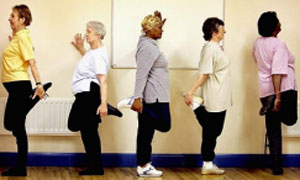Barriers to Exercising
Exercising is key to a healthy, active life and has a whole host of benefits, including increase mood, better mobility, and lowered risk of health problems. Michael R. Bracko, EdD, FACSM, chairman of the American College of Sports Medicine’s Consumer Information Committee, comments, “Exercise is the magic pill. Exercise has been implicated in helping people prevent or recover from some forms of cancer. Exercise helps people with arthritis” (as cited in Zamora, 2008, p.2). Yet despite the benefits of exercising, many people struggle to start and maintain an exercise routine. Much of this is the result of misinformation, intimidation, and lack of motivation. This lesson will address basic information regarding exercise to help you begin your journey to better health.
Fitness Definitions (Adapted from Zamora, 2008)
Fitness terms can add to the intimidation of beginning to exercise. Here are some common phrases and terms along with their definitions:
 Aerobic/cardiovascular activity. These activities are those that speed up your breathing and heart rate. Walking, running, and swimming are examples of these activities.
Aerobic/cardiovascular activity. These activities are those that speed up your breathing and heart rate. Walking, running, and swimming are examples of these activities.- Maximum Heart Rate. A person’s maximum heart rate is based on their age and can be approximated by subtracting your age from 220.
- Flexibility training/stretching. These activities increase the range of motion of joints. Age, and inactivity tend to make muscles shorter, and stretching lengthens these muscles. Stretching cold muscles can damage them, so you should be careful to warm-up first.
- Strength, weight, or resistance training. These exercises target specific muscles to increase their strength and functioning. Examples of these types of activities include weight lifting, using resistance bands, and pushups.
- Set. This term refers to repeating the same exercise for a specific number of times. For example, someone may do 10 push-ups, rest for a minute, and then do another “set” of 10 push-ups.
- Repetition or “rep.” This refers to the number of times you perform a particular activity during a “set.” For example, the person above completed 10 “reps” of the push-up in each set.
- Warm up. A warm-up refers to activities that prepare your body for the stress of exercise. Examples of warm up activities include walking slowly and swinging your arms.
- Cool-down. This term refers to decreasing the level of your activity after a work-out to help your body down. This might refer to walking at a lower speed after jogging. Stretching is an important part of a cool-down as well.
Barriers to Exercise
Many individuals struggle to exercise. Perhaps the most difficult aspect of exercising is beginning a routine that is manageable yet effective. Understanding what stands in your way to exercise can help you find creative methods for incorporating exercise into your routine.
Problem #1: Time Constraints
A common refrain of those who do not exercise is, “I don’t have the time!”
Many people who say they don’t have time for exercise actually mean that they don’t have time to complete the kind of exercise routine they think is necessary. In fact, it can be much more difficult for some people to begin exercising if they try to tackle a long routine. If you believe you do not have enough time to exercise, reevaluate your exercise goals and try to take on a shorter routine. The important thing is to begin and maintain a higher level of physical activity than your current level. When you are able to successfully maintain a shorter routine, you will be encouraged to add onto that routine. However, if you try to tackle a long, complicated, or difficult routine immediately, it is much easier to let scheduling conflicts prevent you from exercising at all. The discouragement of failing at an exercising routine can be enough to keep you from trying again.
Here are several easy ways to incorporate exercise into a busy routine:
- When a friend wants to talk, ask if you can walk as you talk. This can benefit your fitness in two ways. First, you will begin to associate exercise with a positive experience (talking to your friend), which will increase your likelihood to exercise again. Second, it will establish a healthy and simple routine with your friends. *Tip: Do this with colleagues at work by walking up and down a stairwell during a break.
- Walk to lunch. Whether you pack a lunch or eat out during the work week, find a place that is close enough to walk to. Whether it is a bench nearby or a restaurant two blocks down, take advantage of your lunch break to multitask.
- Park further away from your destination. While this is a simple way to incorporate exercise, it can significantly add to the amount of exercising you do in a day.
- Buy a pedometer to track how much you walk and to easily track improvements. About.com’s excellent article on the types of pedometers can help you compare different models: http://walking.about.com/cs/measure/bb/bybpedometer.htm
- Buy a 10-minute exercise video series. For those who are looking to add a more intense boost of exercise into a busy schedule, there are several exercise video series that have 10 minute segments that include a warm up, aerobic exercises, and a cool-down section all in 10 minutes.
Exercises for the Couch (Adapted from Robinson, Segal, & Smith, 2014)
One of the easiest ways to add exercises for those who are busy is to multitask. These exercises can be easily completed while you watch the evening news. They also help you protect your mobility by developing muscles needed for daily tasks.
- Sit to stand. Move from a sitting position to a standing and back to sitting, 10 times in a row. *Tip: Rest for a minute before repeating this routine.
- Calf stretch. Sit on the edge of the couch and put your feet flat on the floor. Keep the heel of your right foot anchored to the floor, then point your toes toward the ceiling. Repeat with the other leg, 3 times per leg. *Tip: Hold all stretches for at least 30 seconds.
- One Leg Training. Lift one heel back towards your buttocks and hold for 30 to 45 seconds, three times per leg. Hold onto a chair or the wall for stability if needed.
- Shoulder Blade Squeeze. Pinch shoulder blades together without moving your shoulders up. Hold for 10 seconds and repeat 10 times.
- Hand Squeeze. While sitting upright on the couch, hold a basketball or similar-sized ball and squeeze it, as though you are trying to push all the air out of it. Hold for a few seconds and then release. Repeat this exercise 10 times.
Problem #2: Exercise is Boring (adapted from Mayoclinic.org)
 Some individuals find that time is not so much of a hindrance as is the repetitious, boring routine. If boredom is hindering you from exercising, you may need to do more exploration to identify what kinds of exercise are interesting. Additionally, you may try to include short bursts of exercising that are long enough to increase your health and still short enough to prevent boredom.
Some individuals find that time is not so much of a hindrance as is the repetitious, boring routine. If boredom is hindering you from exercising, you may need to do more exploration to identify what kinds of exercise are interesting. Additionally, you may try to include short bursts of exercising that are long enough to increase your health and still short enough to prevent boredom.
Here are several tips to relieving the boredom of exercising:
- Plan to completing weight-training exercises, such as weight lifting, while watching your favorite tv show.
- Try a dance-exercise routine. Many gyms offer dance-exercise programs that are more exciting and interesting than typical exercise routines. If you enjoy the social aspect of gyms but find the typical routine boring, this may be a better fit. If you do not want to go to the gym, try renting a dance-exercise DVD from your local library. Try out several to find one that is not too complicated but fun to do.
- Find an activity that you enjoy. If you enjoy taking photos, find a hiking trail or a beautiful path. If you enjoy talking with friends, plan to take a walk as you talk. If you enjoy sports, find a team at a local gym. If you have kids, have a dance party with them.
- Vary your exercise routines. Find different hiking trails, different bicycle routes, and different exercise routines, and mix up what you do each week.
Problem #3: Physical Limitations
Many individuals have limitations when it comes to exercising. This can prevent many people from beginning an exercise routine. Our second lesson explores ways to exercise when limited mobility is a barrier.
 Aerobic/cardiovascular activity. These activities are those that speed up your breathing and heart rate. Walking, running, and swimming are examples of these activities.
Aerobic/cardiovascular activity. These activities are those that speed up your breathing and heart rate. Walking, running, and swimming are examples of these activities.